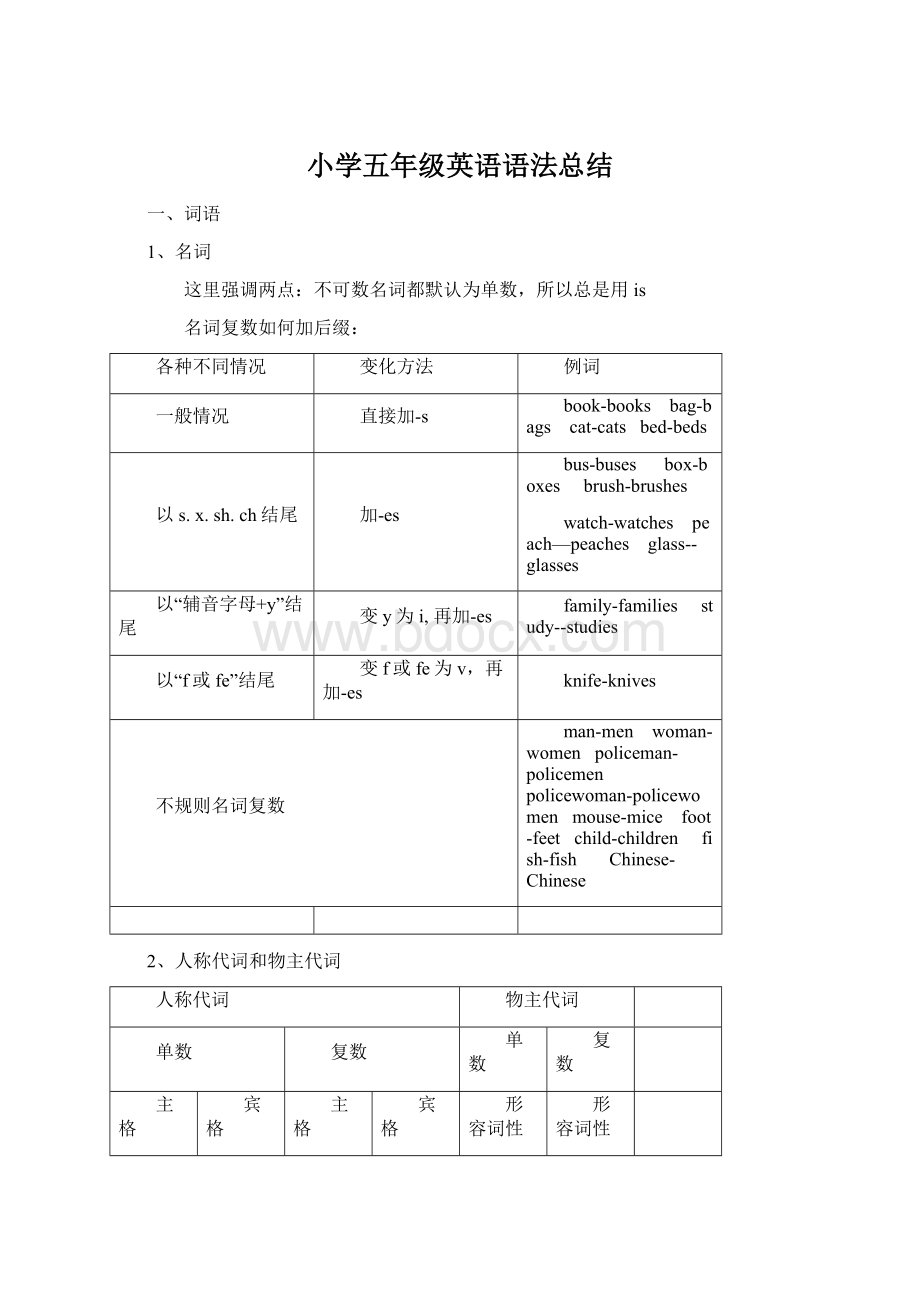小学五年级英语语法总结文档格式.docx
《小学五年级英语语法总结文档格式.docx》由会员分享,可在线阅读,更多相关《小学五年级英语语法总结文档格式.docx(8页珍藏版)》请在冰豆网上搜索。

family-families
study--studies
以“f或fe”结尾
变f或fe为v,再加-es
knife-knives
不规则名词复数
man-men
woman-women
policeman-policemenpolicewoman-policewomen
mouse-mice
foot-feet
child-children
fish-fish
Chinese-Chinese
2、人称代词和物主代词
人称代词
物主代词
单数
复数
主格
宾格
形容词性
第一人称
I(我)
me
we(我们)
us
my(我的)
our(我们的)
第二人称
you(你)
you
you(你们)
your(你的)
your(你们的)
第三人称
he(他)
him
they
(他/她/它们)
them
his(他的)
their
(他/她/它们的)
she(她)
her
her(她的)
it(它)
it
it(它的)
3.Be动词用法
be动词(am、is、are)+not、
情态动词can+not、
助动词(do、does)+not
如何将一个肯定的陈述句改为否定句:
1、看句中有无be动词,如有,直接在be动词后+not。
2、看句中有无情态动词,如有,直接在情态动词后+not。
3、如上述二者都没有,就应用助动词+not。
分四个步骤:
(1)肯定陈述句中本来是没有助动词的,要加上去,位置在主语(某人或某物)后,动词前。
(2)确定助动词用do、does,根据句中动词,动词是原形的助动词就用do,动词是第三人称单数的助动词就用does,
(3)在助动词后加not。
(4)原句中动词假如发生变化就要恢复成原形。
强调一点,有some的要考虑是否要用any。
二、句子
1.一般疑问句
如何将一个肯定的陈述句改为一般疑问句:
(1)看句中有无be动词,如有,把be动词提到句首即可。
(2)看句中有无情态动词,如有,把情态动词提到句首即可。
(3)如上述二者都没有,就应把助动提到句首。
(1)肯定陈述句中本来是没有助动词的,要加上去,位置在主语(某人或某物)后,动词前。
(2)确定助动词用do还是does,根据句中动词,动词是原形的助动词就用do,动词是第三人称单数的助动词就用does
(3)把助动词后提到句首。
2.特殊疑问句
表示疑问,有疑问词(在开头),回答有很多种可能。
常用疑问词:
疑问词
意思
用法
Whattime
什么时间
问具体时间,如几点钟
Who
谁
问人
Whose
谁的
问主人
Where
在哪里
问地点
What
什么
问东西、事物
Whatcolour
什么颜色
问颜色
Howold
多大年纪
问年纪
Howmany
多少数量(可数名词)
问数量
Howmuch
多少钱;
多少数量(不可数名词)
问多少钱或数量(不可数)
三、时态
1.一般将来时
表示将来将要发生的动作,经常和tomorrow,nextyear,thedayaftertomorrow,theyearafterthenext,infivehours'
time,etc.表示将来的词联用。
结构:
主语+助动词will+动词原形
IwillgotoAmericatomorrow.
ThepilotwillflytoJapanthemonthafterthenext.
Jackwillmoveintohisnewhousetomorrowmorning.
★变疑问句将助动词移到句首
WillyougotoAmericatomorrow?
WillthepilotflytoJapanthemonthafterthenext?
WillJackmoveintohisnewhousetomorrowmorning?
★变否定句在助动词后面加not
IwillnotgotoAmericatomorrow.
ThepilotwillnotflytoJapanthemonthafterthenext.
Jackwillnotmoveintohisnewhousetomorrowmorning.
★肯定回答及否定回答
Yes,Iwill./No,Iwillnot.
Yes,he/shewill./No,he/shewillnot.
Yes,hewill./No,hewillnot.
★特殊疑问句
Whatwillyoudo?
2.现在进行时
表示现在正在进行的动作。
构成:
主语+be动词+动词的现在分词+其它成分
Wearehavinglunch.
Heisreadingabook.
Thedogisrunningafteracat.
Theboysareswimmingacrosstheriver.
★变疑问句将be动词移到句首
Arewehavinglunch?
Ishereadingabook?
Isthedogrunningafteracat?
Aretheboysswimmingacrosstheriver?
★变否定句在be动词后面加not
Wearenothavinglunch.
Heisnotreadingabook.
Thedogisnotrunningafteracat.
★特殊疑问句:
what,which,how,where,who,etc.
疑问词+动词+主语+现在分词
Whatareyoudoing?
Whatisshedoing?
Whatisthedogdoing?
没有进行时的动词(必背)
表示状态,思想,感情和感觉的动词不能表示正在进行的动作
1.表示感觉,感官的词
see,hear,like,love,want,
2.have,has当”拥有”讲时没有进行时
3.一般过去式
表示过去发生的动作或事件,常和表示过去的时间状语连用,如yesterday,lastnight,thedaybeforeyesterday,3daysago,
含有be动词的句子,将动词变为过去式,am,is的过去式为was,are的过去式为were
Iwasatthebutcher’s.
Youwereastudentayearago.
Theteacherwasverybeautifultenyearsago.
★变疑问句将be动词移动到句首
Wereyouatthebutcher’s?
Wereyouastudentayearago?
Wastheteacherverybeautifultenyearsago?
★变否定句在be动词后面加not
Iwasnotatthebutcher’s.
Youwerenotastudentayearago.
Theteacherwasnotverybeautifultenyearsago.
★肯定回答否定回答
Yes,Iwas.No,Iwasnot.
Yes,youwere.No,youwerenot.
Yes,he/shewas.No,he/shewasnot.
Whatdidyoudo?
(必背)
不含有be动词的句子,将动词变为过去式
Ifinishedmyhomeworkyesterday.
Theboywenttoarestaurant.
TheSawyerslivedatKingStreetayearago.
★变疑问句在句首加did,动词变为原型
Didyoufinishyourhomeworkyesterday?
Didtheboygotoarestaurant?
DidtheSawyersliveatKingStreetayearago?
★变否定句在主语和动词之间加didnot
Ididnotfinishmyhomeworkyesterday.
Theboydidnotgotoarestaurant.
TheSawyersdidnotliveatKingStreetayearago.
Yes,Idid.No,Ididn’t.
Yes,hedid.No,hedidn’t.
Yes,theydid.No,theydidnot.
4.现在完成时
(1)表示过去发生的和现在有某种联系的动作,常和just,usually,already,since等时间副词连用
Ihavejusthadlunch.(饱了,不用再吃了)
Hehashadacupoftea.(不渴了,不用再喝)
Theyhavealreadyhadtheirholiday.(不能再度假了)
Theboyhasalreadyreadthebook.(已经知道书的内容了,不用再看了)
(2)询问别人是否做过某事一般用现在完成时:
Haveyoufinishedyourhomework?
HaveyoubeentoBeijing?
Haveheseenthefilm?
(3)表示开始于过去并持续到现在的动作
IhavelivedinBeijingfortwentyyears.
Ihaveworkedforthisschoolfor1year.
(4)表示一种经历,经验:
去过…地方,做过…事情,经历过…事情
Ihaveneverhadabath.
Ihaveneverseenafilm.
Ihaveneverbeentocinema.
IhaveeverbeentoParis.
Havebeento表示去过,havegoneto表示去了
IhavebeentoLondon.(人已经回来)
HehasgonetoLondon.(人还在那里)
(5)表示一种结果,一般不和时间副词联用
Ihavelostmypen.
Ihavehurtmyself.
Hehasbecomeateacher.
Shehasbrokenmyheart.
句型变化:
★变疑问句将助动词移到句首,变否定句在助动词后面加not.
e.g.Haveyoulostyourpen?
Ihavenotlostmypen.
★肯定回答及否定回答
Yes,Ihave.No,Ihavenot.
★特殊疑问句:
Whathaveyoudone?
Whathashedone?
一般过去时与现在完成时的区别:
凡是有明确的表示过去的时间状语的句子为过去时
注意:
有些动词表示的动作有一个终点,不能再延续,因此不能和表示一段时间状语连用
错:
I’veleftBeijingfor3days.
对:
IleftBeijing3daysago.Ihavebeenawayfrombeingfor3days.
5.过去完成时
用法:
在过去的时间里,两个动作中,发生在前的那个动作要用过去完成时。
had+过去分词
Aftershehadfinishedherhomework,shewentshopping.
TheyhadsoldthecarbeforeIaskedtheprice.
ThetrainhadleftbeforeIarrivedatthestation.
After/before引导的时间状语从句放在句首要在句子后面加逗号,如果放在主句后则不用加。
1.变疑问句将助动词移到句首
Hadshefinishedherhomework?
2.变否定句在助动词后面加not
Shehadn’tfinishedherhomework.
3.肯定回答及否定回答
Yes,shehad.No,shehadn’t.
4.特殊疑问句:
Whathadshedone?